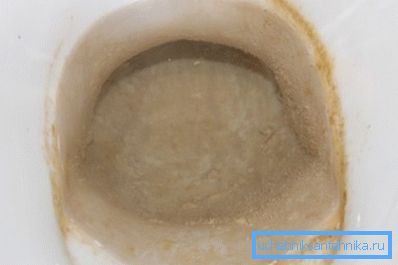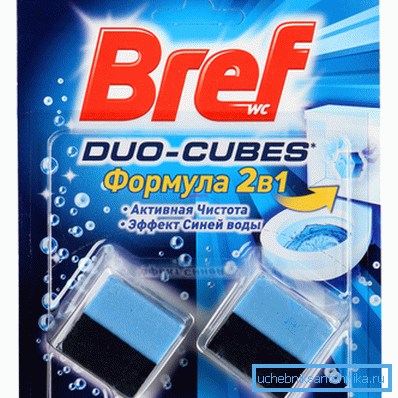How to clean the toilet from the stone: prevention and
Sooner or later, the owner of an apartment with a bathroom has to think about how to clean the toilet from limestone. And although today you can find many suitable products on sale, their effectiveness is very different depending on the composition and conditions of use.
In our article we will tell you what causes the formation of dense deposits in sanitary devices, and also give tips on how to effectively eliminate them with your own hands.

Causes of deposits
Before looking for how to get rid of the stone in the toilet, you need to figure out where it comes from:
- Lime (also known as urinary) stone is a dense deposit on the walls of pipes and the lower part of the toilet bowl.
- The basis of this material is carbonates contained in tap, artesian or well water.
Note! Some water utilities use more modern water treatment facilities. The use of such equipment allows minimizing the amount of carbonates, and therefore, the stone will be formed in smaller volumes.

- In addition, the composition of sediments includes nitrogenous compounds, which are an integral part of fecal masses.
- As a rule, the stone is formed on rough surfaces. That is why new toilet bowls need to be cleaned less often, but over time, the enamel layer loses its properties, and plaque forms more intensively.
Tip! Do you want to do the cleaning no more than once a year - buy porcelain sanitary ware or products from heat strengthened glass. Of course, the price they have is very high, but the quality is incomparable with standard sanitary ware.
Removal technique
The use of specialized drugs
If you are looking for something to clean the toilet from stone and rust, then the easiest way is to use specialized means of industrial production.
Here the following compositions will be effective:

- Powder cleaners with abrasive particles are the cheapest. They are used quite simply: shut off the water, completely remove the liquid from the toilet bowl, then pour the powder and thoroughly clean the walls. The main disadvantage - abrasive particles make the surface rough, so that the treatment will have to be carried out regularly.

- Alkaline compounds ("Domestos" and analogs) dissolve the stone, because they should also be used after complete removal of the liquid. The instruction is quite simple: we apply the tool on the problem area, wait about half an hour and then remove the remnants of sediment using a hard toilet brush.
- If you are looking for how to clean the toilet from a strong limestone stone, you can take acidic alkaline materials instead. ("Silit" and other compositions of a similar action). Concentrated acid in liquid or gel-like form is applied to the walls of the toilet bowl, then we give time for the reaction. After this we complete the cleaning with a brush or rags.

Note! Before you clean the toilet from the stone, you need to completely shut off the water to avoid leakage from an untight tank. Also it is necessary to take care of the protection of hands, wearing rubber household gloves.
Folk remedies
Cleaning the toilet from salt stones in a fast way does not always involve the use of specialized chemistry.
Traditional techniques are quite suitable for our purposes:
- Instead of acidic compounds, almost any acid can be used to remove plaque. Most often, automotive electrolyte, technical oxalic acid in granules, acetic essence, etc. are used for these purposes. (See also the article How to punch a toilet: features.)

- Orthophosphates, which are contained in carbonated drinks, also function well. To remove the plaque in the most gentle way, it is enough to pour about two liters of Coca-Cola into the pre-dried toilet and wait about an hour and a half.
- Finally, you can use soda. However, this method of cleaning is applicable only if the plaque has just begun to form.
Removal of sediments by folk remedies may be less effective, but usually it also helps, if not completely clean the plumbing, then at least bring it into an acceptable form.
Prevention
If you do not want to spend time and money on the fight against limestone, then you should follow a number of simple recommendations:
- First, you need to carefully seal the toilet bowl. The less water will leak, the less sediment will form on the walls.
- Secondly, you can use special tablets, gels or cubes for the cistern. Slowly dissolving in water, they will bind carbonates, and translate them into an inert form. Yes, and with an unpleasant odor, such funds are struggling very effectively.

- Thirdly, at least once every two weeks it is worth carrying out preventive cleaning. For this we use the compositions described above, but we pour them directly into the toilet without removing water. Being in a lower concentration, acids and alkalis still effectively remove the newly formed plaque.
All these tasks are not burdensome, but they will greatly facilitate your life during the general cleaning. The fact is that it is rather difficult to destroy thick layers of lime, because cleaning a toilet bowl, which no one touched for several months, takes a lot of time and effort.
Conclusion
Tips on how to wash the toilet from the stone and how best to do it, you can bring more than a dozen. However, they all boil down to the fact that strong acids and alkalis affect the lime deposits best. So, in principle, you can do without expensive drugs, using your knowledge of chemistry. The video in this article contains additional information on this issue, so it is also worth watching it before cleaning it.